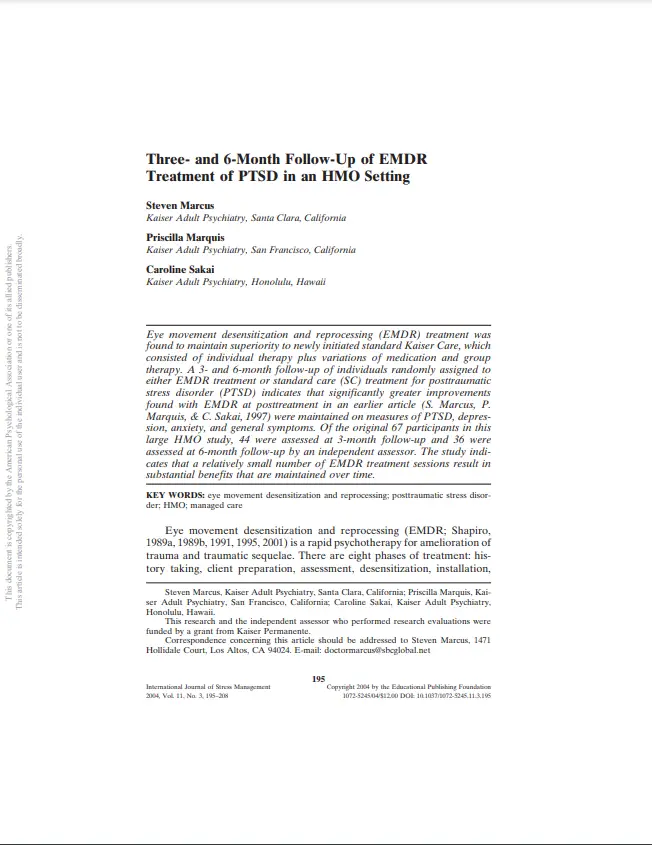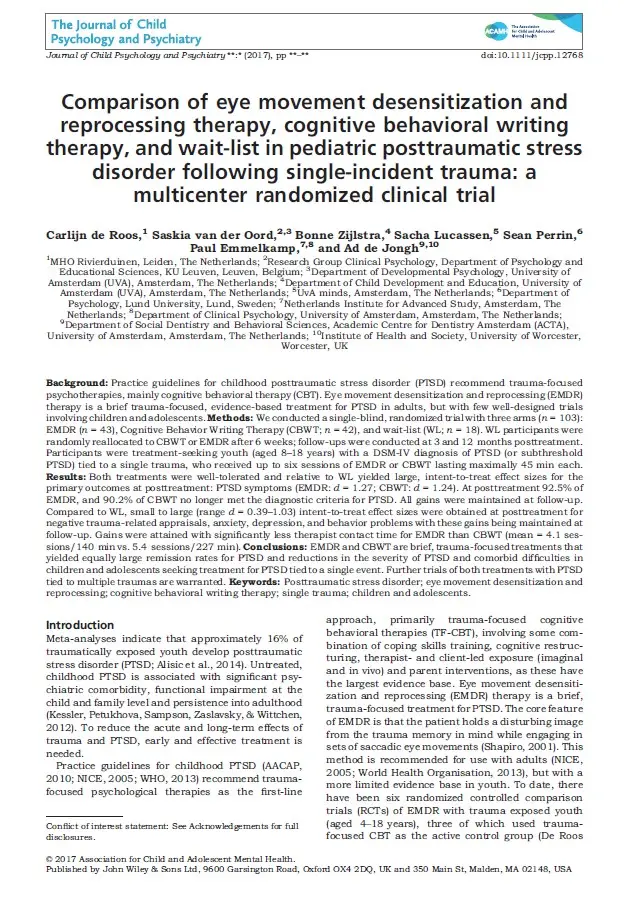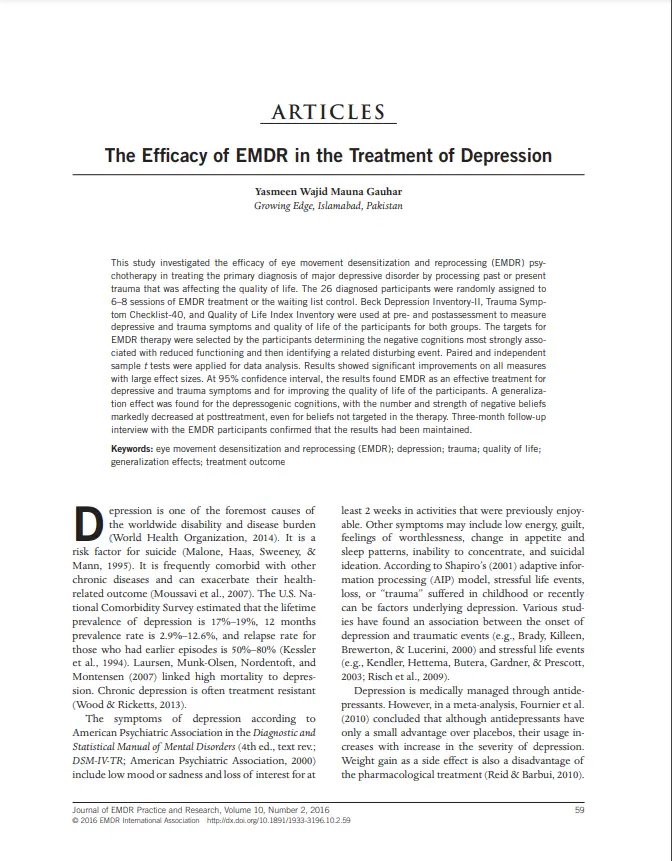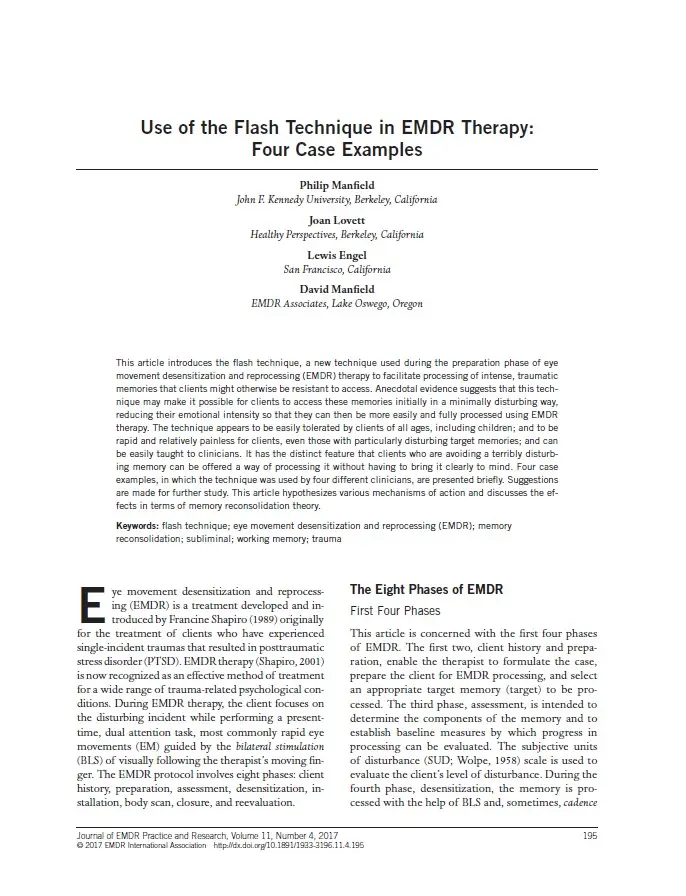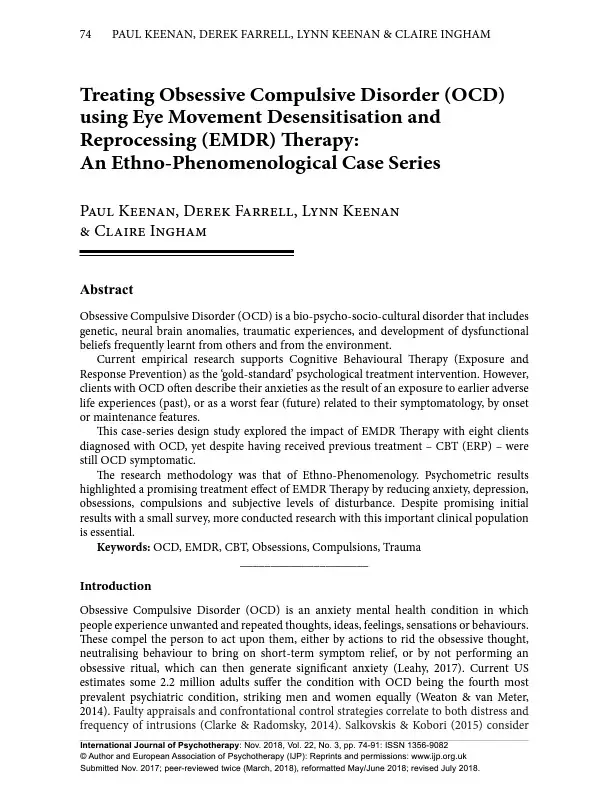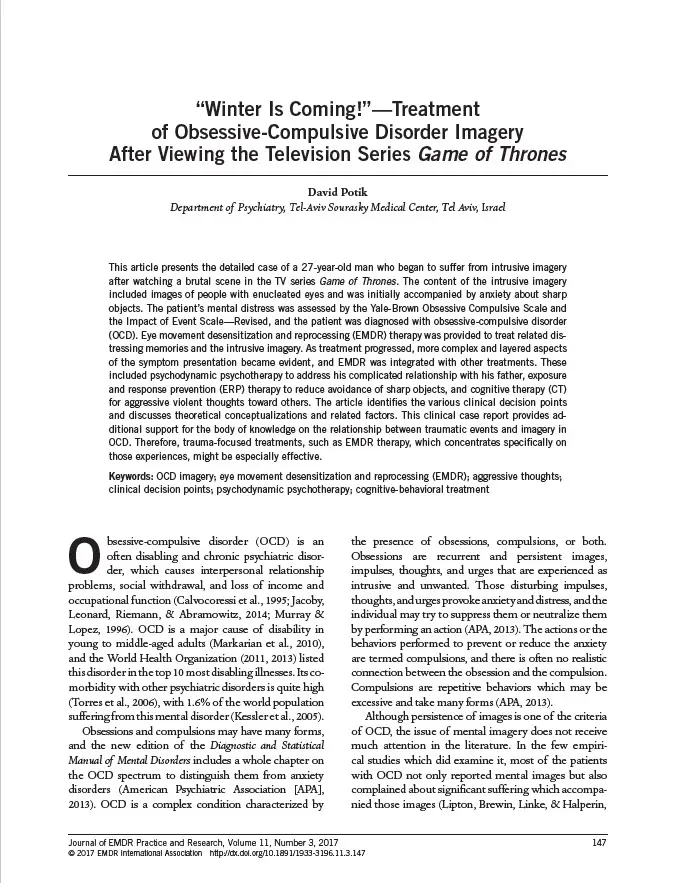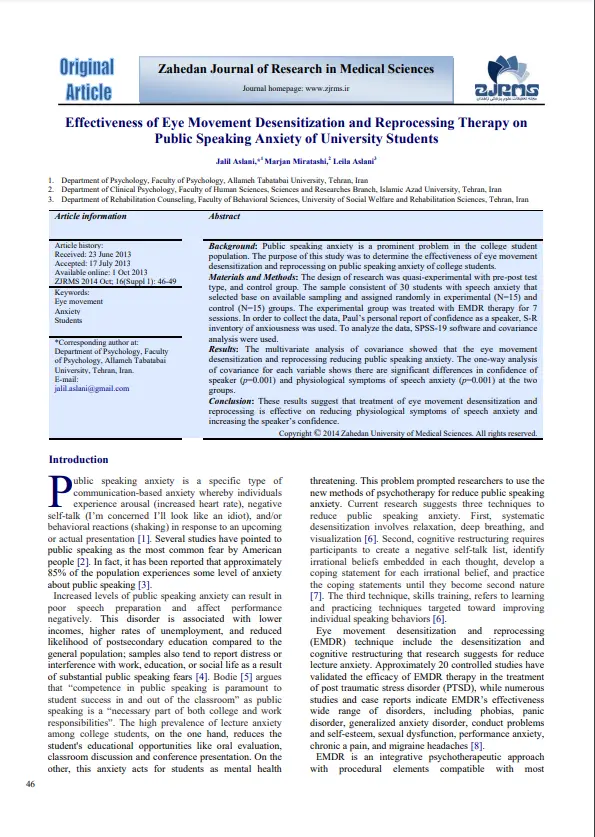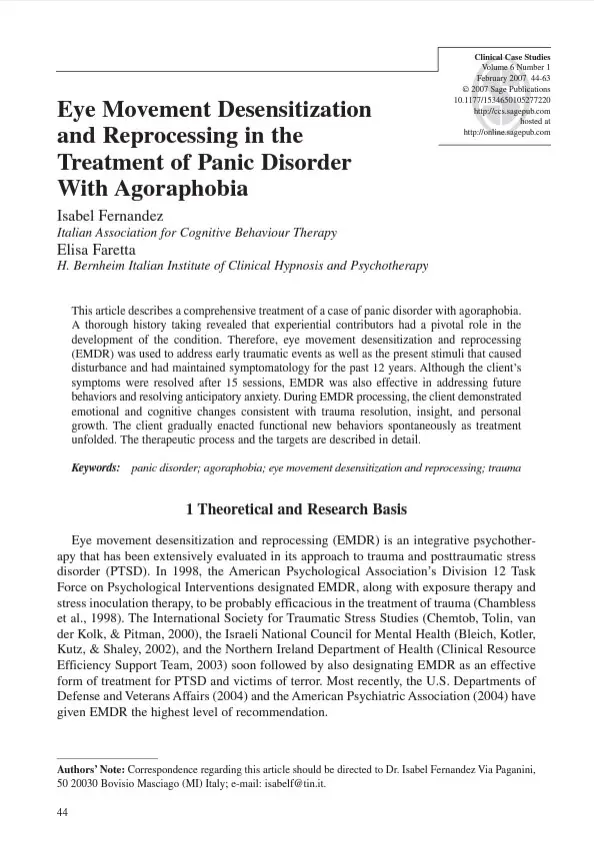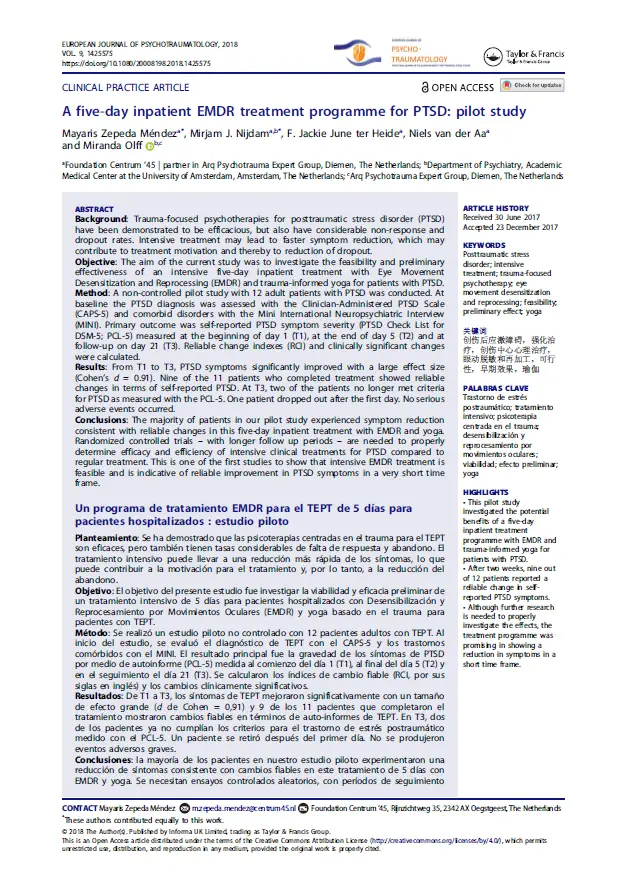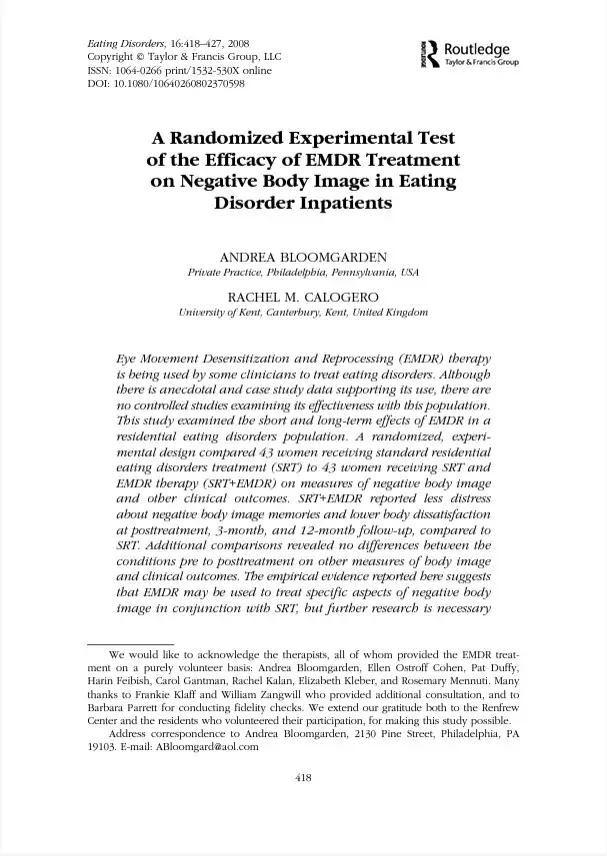Grigore Counselling & Associates
EMDR Evidence
Video By: EMDRIA (EMDR International Association)
EMDR really works.
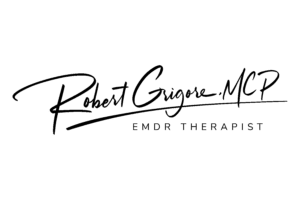
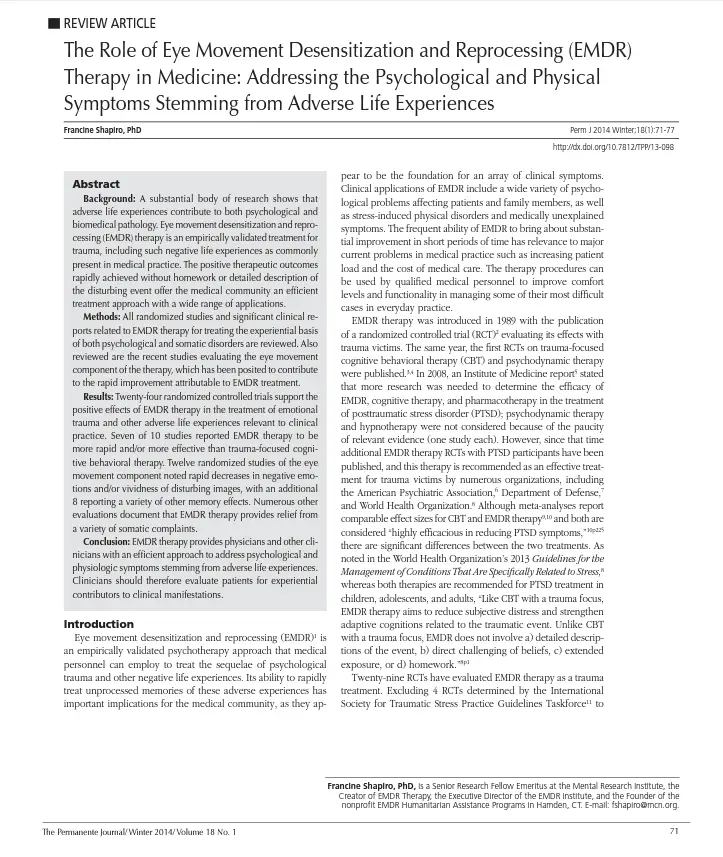
Shapiro, F., 2014. The role of Eye Movement Desensitization and Reprocessing (EMDR) therapy in medicine: Addressing the psychological and physical symptoms stemming from adverse life experiences. The Permanente Journal. Winter; 18(1): 71-77. http://dx.doi.org/10.7812/TPP/13-098
EMDR vs. CBT
7 Randomly Controlled Trials (RCT) indicated EMDR to be more rapid or otherwise superior to CBT.
EMDR
- 8 sessions with no homework
CBT
- 4 sessions of imaginal exposure (describing the trauma)
- 4 sessions of in vivo exposure (physically going to a disturbing location)
- 50 hours of combined imaginal and in vivo exposure homework
Study by Kaiser Permanente reported 100% of single-trauma victims and 77% of multiple-trauma victims no longer had PTSD after approximately six 50-minute EMDR sessions.
2 other RCTs found that 84% to 90% of single-trauma victims no longer had PTSD after three 90-minute EMDR sessions.
EMDR & PTSD
Back in 2004, Marcus et al. compared EMDR treatment with “Standard Care” i.e. “Traditional Therapy” (Cognitive, Psychodynamic, Behavioural, Medication, and Group Therapy), finding EMDR obtained clinically significant results in 1/4 the time.
EMDR
- 50% of participants no longer met PTSD diagnosis after 3 sessions
- 77% of participants no longer met PTSD diagnosis after 6 sessions
- Results were maintained at 3 and 6 month follow-ups
Traditional Therapy
- It took 11 Sessions for randomly assigned participants to no longer meet PTSD diagnosis

Shapiro, F., 2014. The role of Eye Movement Desensitization and Reprocessing (EMDR) therapy in medicine: Addressing the psychological and physical symptoms stemming from adverse life experiences. The Permanente Journal. Winter; 18(1): 71-77. http://dx.doi.org/10.7812/TPP/13-098
EMDR vs. Prozac
Study by National Institute of Mental Health indicated EMDR was superior for eliminating both PTSD symptoms and Depression symptoms after 8 weeks of treatment.
EMDR
- EMDR group continued to improve after completion of treatment
- 91% no longer had PTSD symptoms
Fluoxetine (Prozac)
- Participants became symptomatic again at post-test
- 72% reported no longer having symptoms
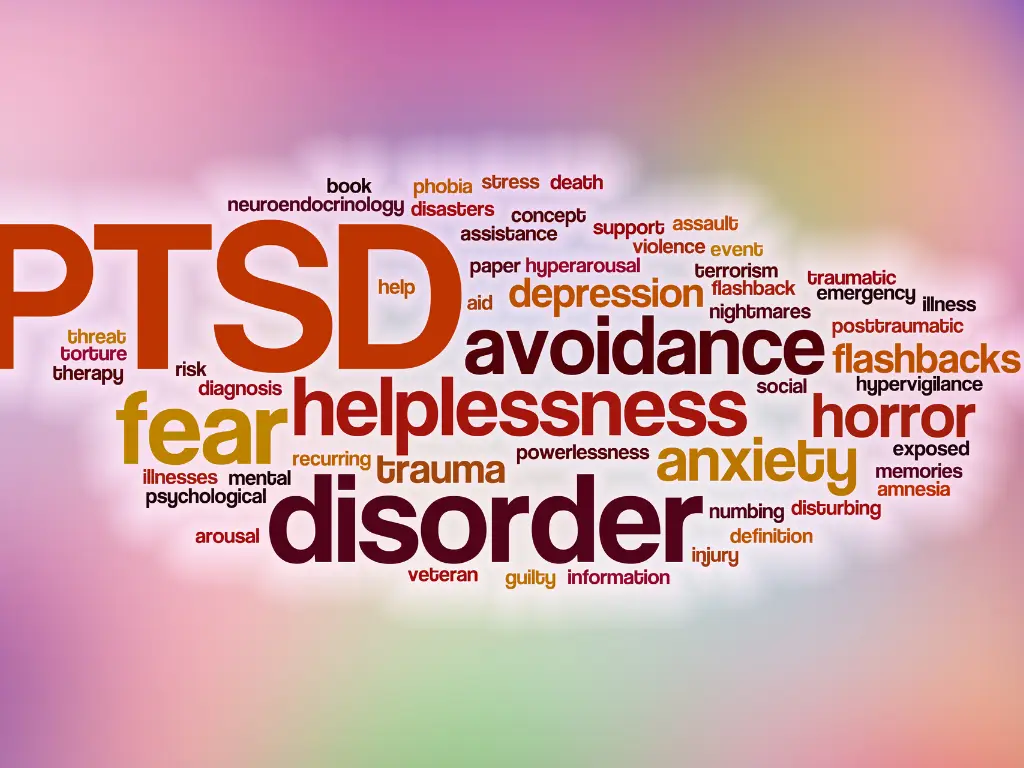
Earlier studies by Rothbaum, 1997; and Wilson et al., 1995, 1997, indicated similar results for EMDR’s efficacy for healing PTSD, where 84% to 100% of single trauma survivors only needed three 90-minute sessions to no longer meet the PTSD diagnosis.
Furthermore studies with combat veterans and civilians who suffered from multiple traumatic experiences, found that after 12 sessions, 77%-78% no longer had PTSD (Marcus et al., 1997, 2004).
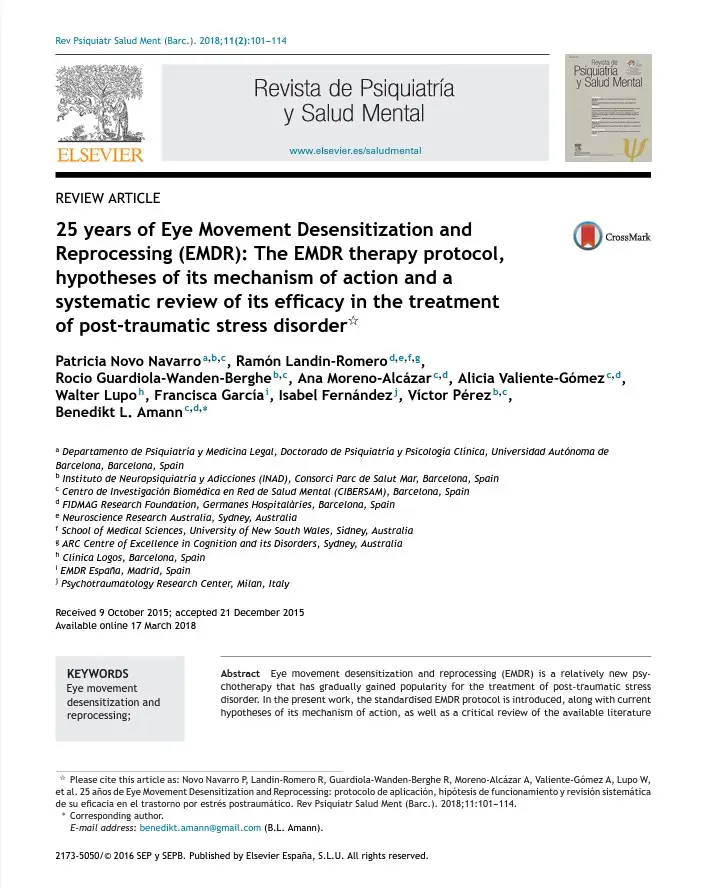
Novo Navarro P, Landin-Romero R, Guardiola-Wanden-Berghe R, Moreno-Alcázar A, Valiente-Gómez A, Lupo W, et al. 25 years of Eye Movement Desensitization and Reprocessing (EMDR): The EMDR therapy protocol, hypotheses of its mechanism of action and a systemic review of its efficacy in the treatment of post-traumatic stress disorder. Rev Psiquiatr Salud Mental (Barc.). 2018;11:101—114.
EMDR & PTSD
11 Clinical Trials Compared the Efficacy of EMDR With Other Specific Treatments to Treat PTSD…
- EMDR vs. Long-Term Imaginary Exposure
- EMDR vs. Muscle Relaxation
- EMDR vs. Biofeedback Assisted Muscle Relaxation
- EMDR vs. Trauma-Centered CBT
- EMDR vs. Prolonged Exposure With Cognitive Restructuring
- EMDR vs. A Stress Inoculation Programme
- EMDR vs. Pharmacological Treatment
- EMDR vs. Emotional Expression Techniques
- EMDR vs. Short Eclectic Therapy
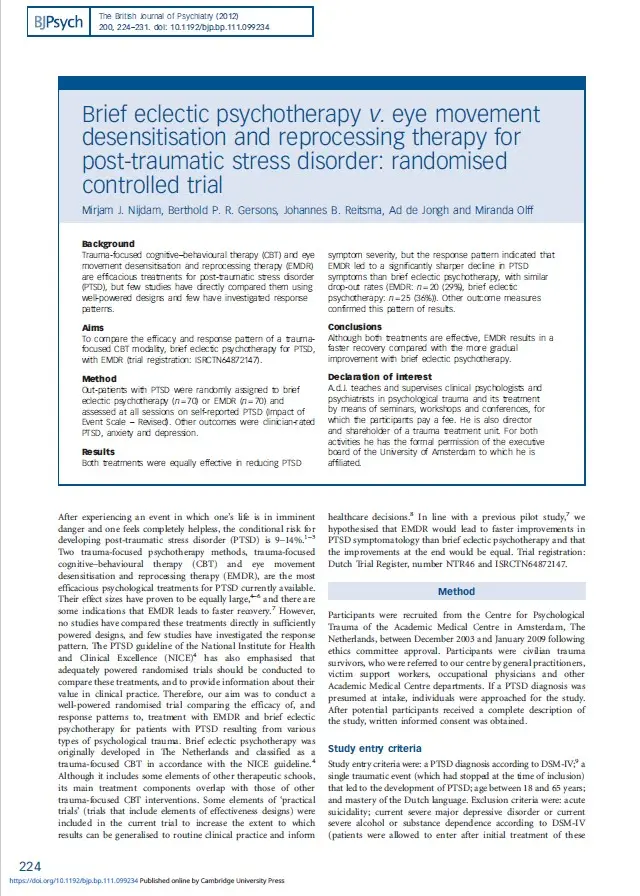
Nijdam MJ, Gersons BP, Reitsma JB, de Jongh A, Olff M. Brief eclectic psychotherapy v. eye movement desensitisation and reprocessing therapy for post-traumatic stress disorder: randomised controlled trial. Br J Psychiatry. 2012 Mar;200(3):224-31. doi: 10.1192/bjp.bp.111.099234. Epub 2012 Feb 9. PMID: 22322458.
EMDR vs. BEP
Researchers compared EMDR with Brief Eclectic Psychotherapy to treat PTSD symptoms and found that while both treatments resulted in similar outcomes after 17 weeks, EMDR’s results came much faster (PTSD symptoms were halved after just 6 sessions).
Researchers also noted that the treatment approaches were significantly different: Brief Eclectic Psychotherapy required participants to reveal every detail of their trauma (uninterrupted for 15-20 minutes), while EMDR only required participants to think of it for 2-3 minutes.
When Brief Eclectic Psychotherapy introduced Cognitive Restructuring, participants’ results did improve at a similar rate as EMDR; however EMDR participants were not required to engage in homework assignments.
de Roos C, van der Oord S, Zijlstra B, Lucassen S, Perrin S, Emmelkamp P, de Jongh A., 2017. Comparison of eye movement desensitization and reprocessing therapy, cognitive behavioral writing therapy, and wait-list in pediatric posttraumatic stress disorder following single-incident trauma: a multicenter randomized clinical trial. J Child Psychol Psychiatry. 2017 Nov;58(11):1219-1228. doi: 10.1111/jcpp.12768. Epub 2017 Jun 28. PMID: 28660669.
EMDR & PTSD (Children)
At post-treatment 92.5% of EMDR, and 90.2% of CBWT no longer met the diagnostic criteria for PTSD. All gains were maintained at follow-up. Those in the waitlist group experienced heightened anxiety, depression, and PTSD symptoms.
EMDR
- EMDR treatment time averaged 4.1 sessions (140 min)
CBWT
- CBWT treatment time averaged 5.4 sessions (227 min)
Video By: VEN EMDR Association
EMDR is Life-Changing.

EMDR & Depression
The most common approach to treating depression for decades has been a combination of Cognitive Behavioural Therapy (CBT) with medication.
However, this study provided strong evidence for EMDR to be far superior to CBT…
EMDR
- 95% “Effectiveness Rate” for treating depression and only required 6-8 sessions for noticeable improvement
- Depression “Relapse Rate” was 0%
CBT + Medication
- 40-50% “Effectiveness Rate” and required far more sessions
- Depression “Relapse Rate” was 50-80%
EMDR changed my life, and the lives of the 1000+ clients we've had the privilege of serving.
I spent my first few years as a Registered Clinical Counsellor, practicing talk therapy, while working primarily with male survivors of sexual abuse.
Although the work was helpful, I began to feel I was burning out. Each session felt we were going in circles. I needed to find a better way to help my clients…or I feared, I’d need to begin a new career.
After discovering and practicing EMDR, I realized all the work I had been doing as a talk therapist wasn’t wasted…but it was just Phase 1 and Phase 2 of EMDR’s Standard Protocol.
Most importantly, with EMDR the results showed up very quickly for my clients, and from then on, I dove 100% into EMDR, and have never looked back.
EMDR & Anxiety
Flash Technique was used effectively for all four cases studied, with 100% reducing their distress completely.
During the Flash Technique the client is instructed NOT to focus on the trauma / disturbance, and to engage in positively engaging taxing activities (Flash).
Therefore, The Flash Technique can be thought of as “the back door” method of working through difficult issues.
EMDR & OCD
100% of participants completely eliminated the distress related to OCD symptoms, and results improved over time.
Gold Standard for treating OCD has been Cognitive Behavioural Therapy (Exposure and Response Prevention). However, clients with OCD often resist exposure to earlier life experiences or their worst fear related to their symptomology.
Psychometric results highlighted a promising treatment effect of EMDR Therapy by reducing anxiety, depression,
obsessions, compulsions and subjective levels of disturbance.
EMDR + CBT for OCD Imagery from TV Show: Game of Thrones
After watching the popular TV series Game of Thrones, client experienced anger-related OCD symptoms.
Standard EMDR in combination with CBT was used to effectively neutralize disturbing images and fears associated.
Results were maintained at follow-up.
EMDR & Performance Anxiety (Public Speaking)
85% of human population experiences some level of anxiety about public speaking. (Burnley, M., Cross, P., Spanos, N. The effects of stress inoculation training and skills training on the treatment of speech anxiety. Imagin Cogn Pers. 1993; 12(4): 355-366).
Researching the effects of EMDR on public speaking anxiety of university students, Ashani et al., found EMDR was a effective for reducing physiological symptoms of speech anxiety and increasing the speaker’s confidence.
EMDR & Panic Disorder With Agoraphobia
All the way back to 2007, Fernandez and Faretta presented a case study which was consistent with 20 other cases in their practice of individuals suffering from Panic Disorder with Agoraphobia (fear of going outside).
EMDR results were:
- Elimination of anxiety and panic attacks
- Elimination of avoidance behaviors
- Establishment of independent functioning through the ability to be alone and drive
- Resolution of agoraphobic symptoms
- Insight and understanding about symptoms and secondary gains
- Establishment of a new self-perception, which included an adjustment of interpersonal relationships
- Return to normal daily life functioning
Mendez, M. Z., Nijdam, Mj., June ter Heider, J., van der Aa, N., & Olff, M. 2018. A five-day inpatient EMDR treatment programme for PTSD: pilot study. European Journal of Psychotraumatology. Vol. 9, 1425575. https://doi.org/10.1080/20008198.2018.1425575
EMDR & 5-Day Intensive for PTSD
Study consisted of 5 days of combination of EMDR and yoga (13.5-15 hours of EMDR and 4-5 hours of yoga).
82% of participants reported improvement with PTSD symptoms.
No participants dropped out due to intolerability and no serious harm nor adverse events occurred (only 1 dropout due to change of treatment goal).
Researchers consider an even more intensive approach or a two-week program may be more beneficial for Complex-PTSD.
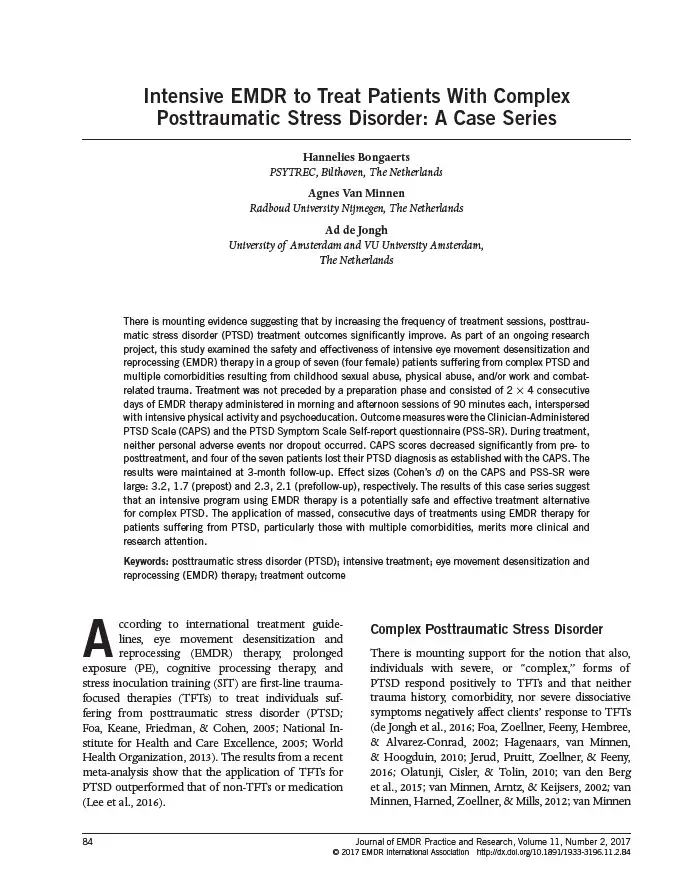
Bongaerts, H., Van Minnen, A., & de Jongh, A. 2017. Intensive EMDR to treat patients with complex posttraumatic stress disorder: A case series. Journal of EMDR Practice and Research. Vol. 11(2). EMDR International Association. http://dx.doi.org/10.1891/1933-3196.11.2.84
EMDR & 8-Day Intensive for CPTSD
4 of 7 participants lost their PTSD diagnosis, with 2 experiencing complete remission (no symptoms). Study consisted of 2 sets of 4 consecutive days of 3-hour EMDR intensives (90 minutes in morning and 90 minutes in afternoon) combined with physical activity and psychoeducation, with no stabilization phase. No adverse affects or adverse events occurred during intensive treatment, indicating patients did not decompensate.
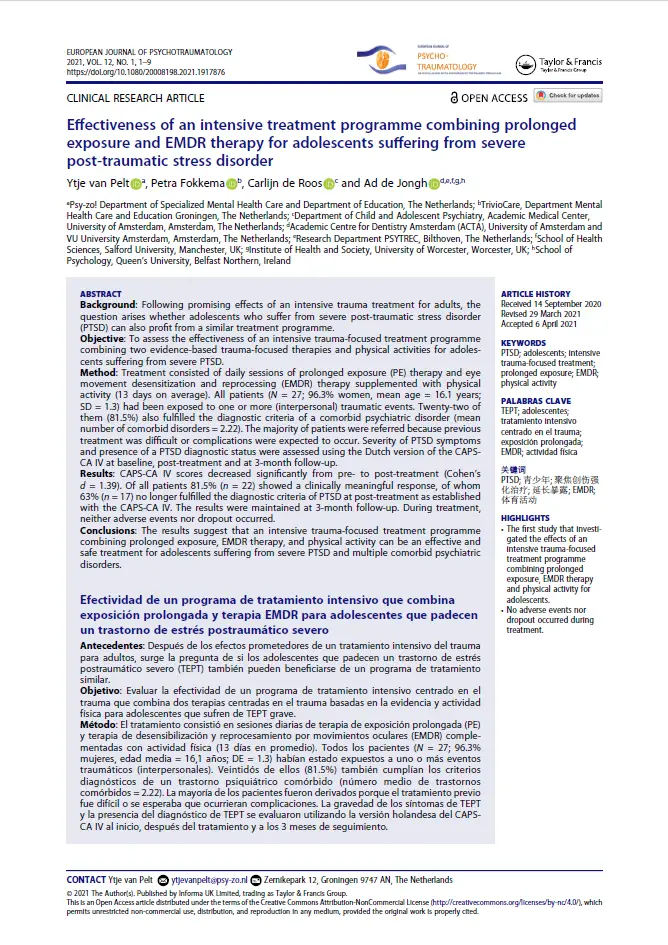
Bongaerts, H., Van Minnen, A., & de Jongh, A. 2017. Intensive EMDR to treat patients with complex posttraumatic stress disorder: A case series. Journal of EMDR Practice and Research. Vol. 11(2). EMDR International Association. http://dx.doi.org/10.1891/1933-3196.11.2.84
EMDR Intensive Adolescents & Teens
This study found that an intensive trauma-focused treatment combining prolonged exposure, EMDR therapy, and physical activity led to significant reductions in PTSD symptoms in adolescents and teens, with 81.5% showing clinically meaningful improvement. Of these, 63% no longer met the PTSD criteria at post-treatment, and results were sustained at 3-month follow-up. No adverse events or dropouts occurred during treatment, suggesting the program is both effective and safe for adolescents and teens with severe PTSD and comorbid psychiatric disorders.
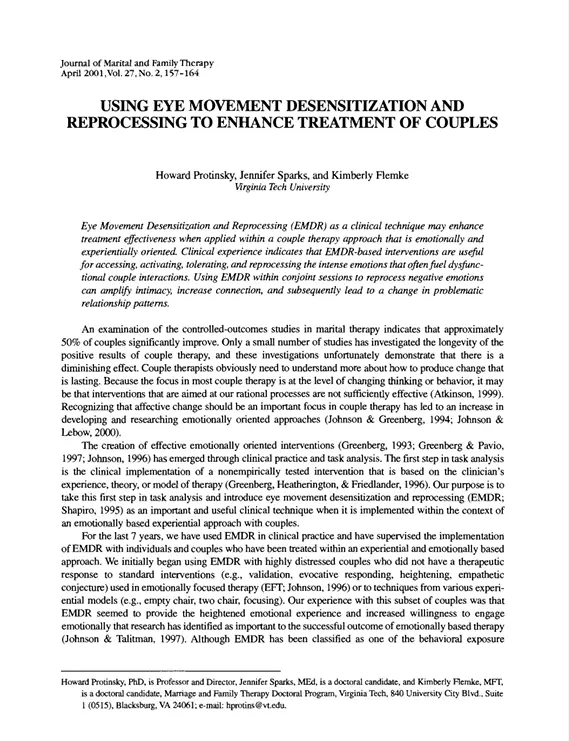
Protinsky, H., Sparks, J., & Flemke, K. (2001). Using Eye Movement Desensitization and Reprocessing to enhance treatment of couples. Journal of Marital and Family Therapy. Vol 27(2): 157-164. Retrieved from: https://acrobat.adobe.com/id/urn:aaid:sc:VA6C2:a6e33e04-e9d2-4286-aac0-b8e6e7aa005d
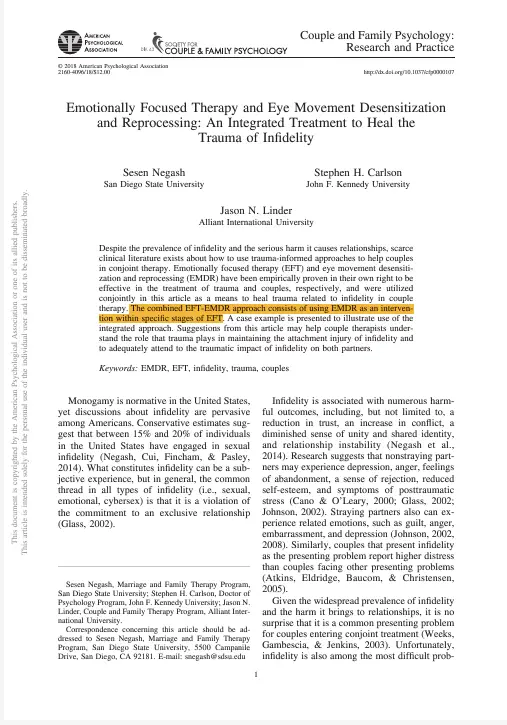
Negash, S., Calson, S. H., & Linder, J. N. (2018). Emotionally Focused Therapy and Eye Movement Desensitization and Reprocessing: An integrated treatment to heal the trauma of infidelity. Couple and Family Psychology: Research and Practice (American Psychology Association), 2160-4096(18). Retrieved from: https://http://dx.doi.org/10.1037/cfp0000107?
EMDR & Couples
EMDR when integrated with couples counselling, has been shown to significantly improve satisfaction, communication, and overall emotional well-being in relationships, with the benefits continuing six months after the intervention.
Furthermore, EMDR was evidenced to be highly effective in helping couples process emotional trauma associated with infidelity, leading to forgiveness, a greater sense of trust, and the possibility of rebuilding the relationship.
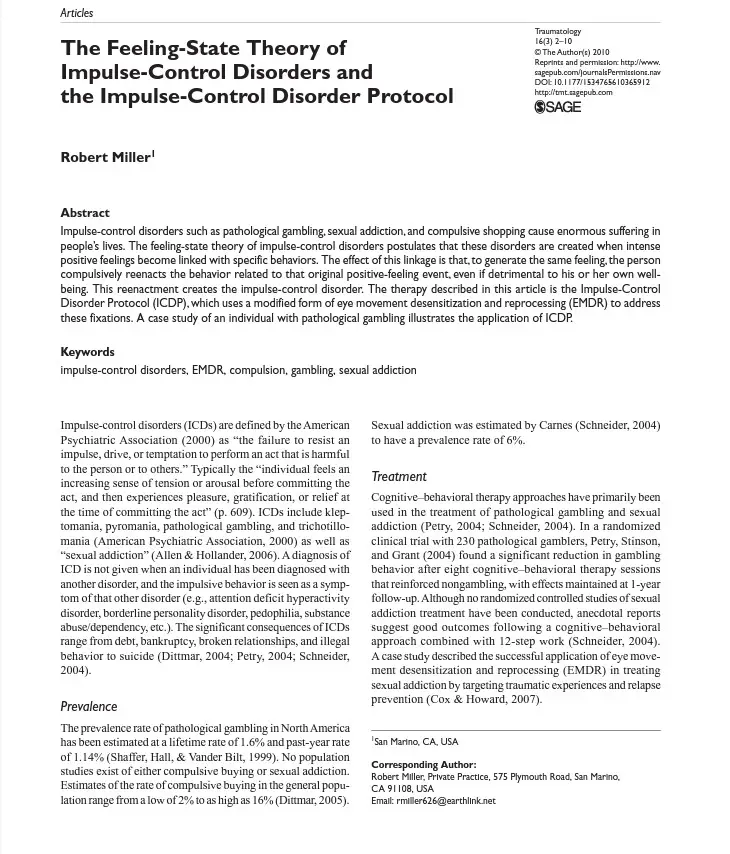
Miller, R. 2010. The feeling-state theory of impulse-control disorders and the Impulse-Control Disorder Protocol. Traumatology, 16(3), pp 2-10. DOI: 10.1177/1534765610365912

Hien, D. A., Jiang, H., Campbell, A, N.C., Hu, M-C., Miele, G. M., Cohen, L. R., Brigham, G. S., Capstick, C., Kulaga, A., Robinson, J., Suarez-Morales, L., & Nunes, E. V. 2010. Do treatment improvements in PTSD severity affect substance use outcomes? A secondary analysis from a randomized clinical trial in NIDA’s Clinical Trials Network. American Journal of Psychiatry., 167: 95-101. Retrieved from https://aip.psychiatryonline.org
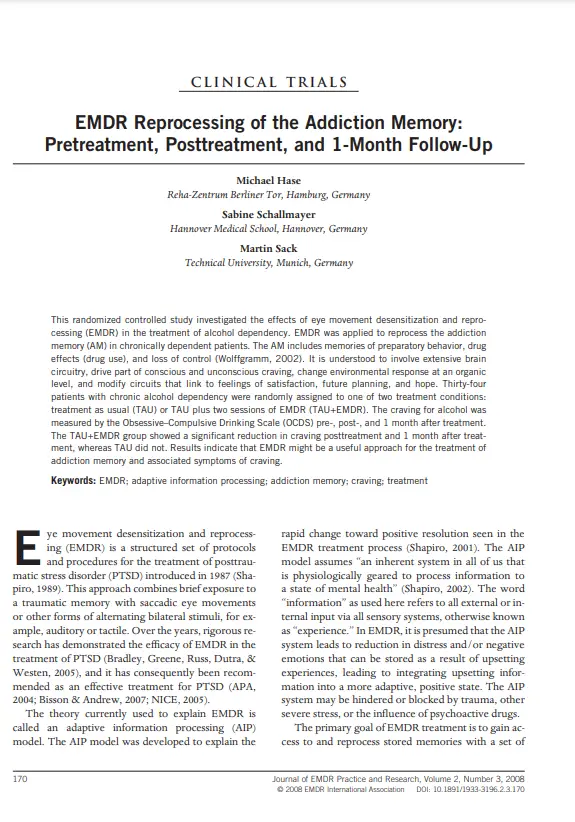
Hase, M., Schallmayer, S., & Sack, M. 2008. EMDR reprocessing of the a d d i c t i o n memory: Pretreatment, posttreatment, and 1-month follow-up. Journal of EMDR Practice and Research. Vol. 2(3)
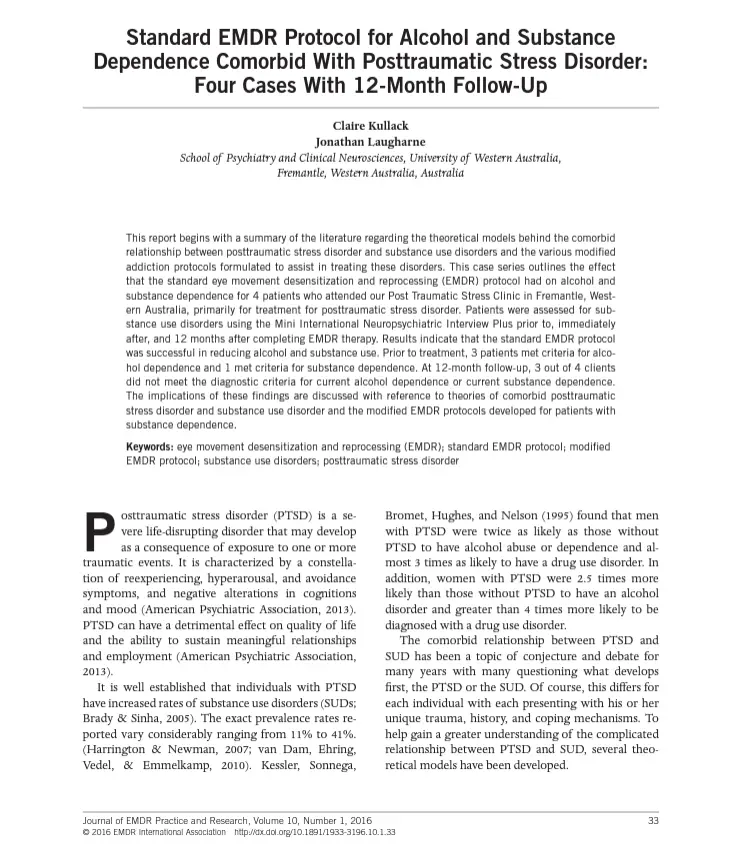
Kullack, C., Laugharne, J. (2016). Standard EMDR protocol for alcohol and substance dependence comorbid with posttraumatic stress disorder: Four cases with 12-month follow-up. Journal of EMDR Practice and Research, Vol 10(1). EMDR International Association. Retrieved from: http://dx.doi.org/10.1891/1933-3196.10.1.33
EMDR & Substance Abuse
According to Robert Miller’s Feeling State Theory of Impulse-Control Disorders (2010), compulsive behavior arises when a positive emotion becomes linked to a specific behavior, offering a perceived sense of control over otherwise overwhelming emotions. For instance, an individual may turn to alcohol to numb the intense powerlessness experienced after the loss of a loved one. Any behaviour, such as exercise, work, shopping, sex, video games, and substance use, can become addictive, serving as a “lever” pulled by individuals to experience positive feelings during moments of distress.
Studies indicate that trauma and/or PTSD symptoms underly addictive behaviour (Miller 2010, Hien et al., 2010).
Hien et. al (2010) studied 353 women and discovered that reducing PTSD symptoms improved substance abuse behaviour while reducing substance abuse behaviour did not improve PTSD symptoms (this study indicated the importance of healing trauma to improve substance abuse disorders).
In 2008, Hase et. al, conducted a controlled trial with 34 participants suffering from alcohol dependency and discovered that including EMDR with treatment as usual (TAU) was far superior than TAU (i.e. group with no EMDR) as the TAU+EMDR group showed a significant reduction in craving before treatment, after treatment, and at the one month follow up.
EMDR treatment addressing PTSD + Substance Dependence found 100% of participants no longer met criteria for substance dependence, 75% no longer met criteria for alcohol dependence, and 100% no longer met criteria for PTSD diagnosis at 12-month follow-up.
EMDR & Eating Disorders + Negative Body Image
A randomized, experimental design compared 43 women receiving standard residential eating disorders treatment (SRT) to 43 women receiving SRT and EMDR therapy (SRT+EMDR) on measures of negative body image and other clinical outcomes. SRT+EMDR reported less distress about negative body image memories and lower body dissatisfaction at posttreatment, 3-month, and 12-month follow-up, compared to SRT.

